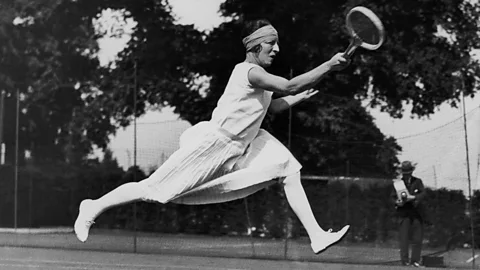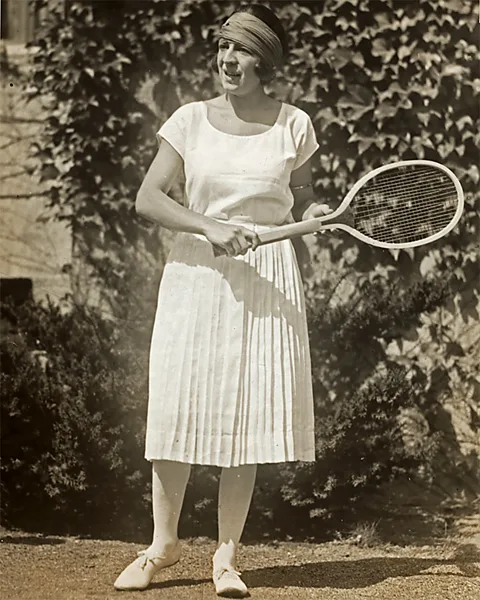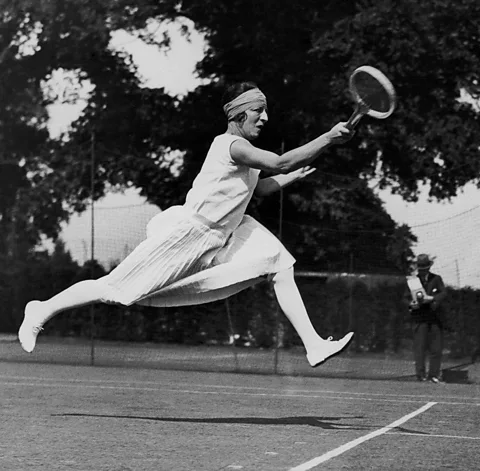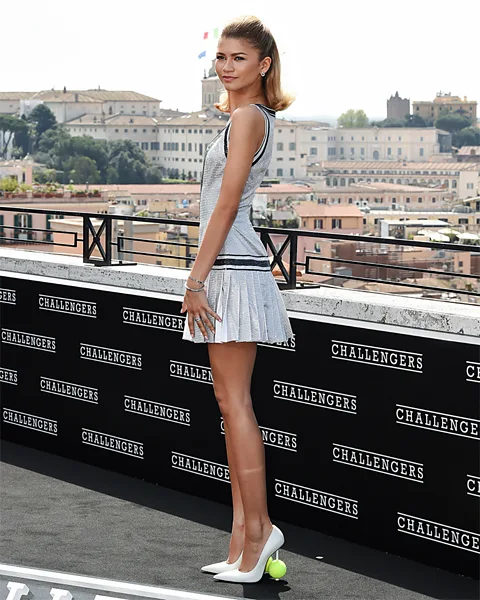[ad_1]
 Getty Images
Getty ImagesAfter the French Open unveiled a new roof for their court named after Suzanne Lenglen – its concertina-style design inspired by her pleated skirts – a look at the 1920s athlete who blazed a trail for modern sports stars.
As the rain lashed down in the first week of this year’s French Open championship, it wasn’t long before tennis fans got a look at the brand-new roof on Stade Roland Garros’ Court Suzanne-Lenglen, the tournament’s second biggest stadium. Featuring canvas fabric that unfolds slowly across the court like a concertina, the structure has some unusual architectural inspiration – the famous pleated skirts once worn by the court’s namesake.
Today, many spectators seated under the roof might know little about the player who inspired it other than her name – yet a century ago, Lenglen was not only the most celebrated tennis player in the world, but one of the most famous women, too. An icon of the Jazz Age who brought a radical new style to tennis, both on and off the court, she changed sport – and fashion – forever.
 Getty Images
Getty ImagesTennis and fashion have long had a close relationship, and tennis style is in the spotlight again – helped by Luca Guadagnino’s film Challengers, which had Loewe creative director Jonathan Anderson as costume designer, and its star Zendaya wore a succession of tennis-inspired looks for her promotional tour. The #tenniscore aesthetic is all over TikTok, and fashion houses are snapping up players to front their campaigns.
Former on-court rivals Roger Federer and Rafa Nadal appear together in a new Louis Vuitton advert. Italian player and Australian Open champion Jannik Sinner is a brand ambassador for Gucci. Spaniard Carlos Alcaraz – who beat Novak Djokovic in last year’s thrilling Wimbledon final – has appeared in Calvin Klein and Louis Vuitton campaigns. British star Emma Raducanu has a contract with Dior, while Coco Gauff graced the cover of US Vogue this year. But no player did more to grow the relationship between tennis and fashion than France’s Suzanne Lenglen.
Born in Paris in 1899, Lenglen first picked up a tennis racket at the age of 11, and quickly showed a talent for the game. Seeing her potential, her father became not just a pushy parent, but a ruthless and demanding coach, making her practice for hours, and berating her for every mistake.
By 15, Lenglen had won the World Hardcourt Championship, but her career was curtailed by World War One. When tennis resumed in 1919, she was fully ready to make her mark – and she did it in some style.
That year, aged 20, Lenglen played Wimbledon for the first time and easily made her way through to the final, where she faced 40-year-old Brit – and seven-time defending champion – Dorothea Douglass Chambers. The contrast couldn’t have been starker: it was a clash of old new v new, tradition v progress, pre-war v post-war.
At this point, the standard attire for female tennis players included a corset and a petticoat, but Lenglen wore neither. Instead, she stepped on to the court – in front of King George V and Queen Mary – wearing a short-sleeved pleated dress, the hemline of which fell just below her knee, exposing the top of her rolled down silk stockings as she played. It was a stark contrast to the ankle-length skirt and high-necked blouse of her opponent. Even her suntan was radical.
“People were absolutely horrified because she clearly wasn’t wearing a corset,” says Elizabeth Wilson, author of Love Game: A History of Tennis, from Victorian Pastime to Global Phenomenon. “Her whole appearance was in complete contrast to the Edwardian norm as it were, and people found it shocking and obscene.” The press called it indecent, but soon every female player would be following her lead.
 Getty Images
Getty ImagesBesides, Lenglen was too busy winning to care – not only that 1919 Wimbledon final, but five of the next six as well (she withdrew from the tournament in 1924 for health reasons). Dominant barely begins to cover her achievements, with Lenglen only losing one singles match – and three sets of tennis – in seven years. She scooped Olympic gold and twice won the “triple” (singles, doubles and mixed doubles) at the French Open. So impressive was her streak it even inspired a line in Ernest Hemingway’s 1926 novel The Sun Also Rises, in which one character “probably loved to win as much as Lenglen”.
Lenglen’s aggressive, physical style of play was much more akin to the male players of the time, her overhead serve then unheard of for a female player. Her acrobatic, often balletic moves were made all the easier by her outfits.
She wasn’t afraid to show passion and personality on the court, either. Sporting her signature blunt bob and red lips, she sipped brandy between sets to calm her nerves. When officials stopped her bringing in her hip flask, she had her father throw sugar cubes soaked in cognac from the stands instead.
“Her success, her style, and her charismatic persona arrived at a point when people were craving a distraction from their lives and the state of the world,” says artist and illustrator Tom Humberstone, who was so captivated by Lenglen’s story he based his first graphic novel, Suzanne, on her life.
The French press – delighted to have something to celebrate after the war – called her Notre Suzanne (our Suzanne) and, famously, La Divine (The Goddess). Lenglen had box-office appeal – the popularity of her matches was one of the reasons Wimbledon moved to a larger venue in 1922 – and brought a legion of new fans to the game.
“Suzanne made women’s tennis undeniable,” Humberstone tells the BBC. “She was the biggest name in tennis at the time and arguably the biggest name in sport.”
But it was her fashion that was most revolutionary of all. “The fact that women were playing in tight-fitting whalebone corsets hampered their ability to play freely, and was detrimental to their health,” says Humberstone. “By eschewing the corset in favour of free-flowing, androgynous dresses, she made it possible for women to play the sport with freedom – while also paving the way for the 1920s flapper aesthetic.”
Lenglen’s trademark sleeveless dresses were the work of French designer Jean Patou, then a rival of Coco Chanel, who turned the tennis star into his muse. It certainly paid off – between 1919 and 1924, the fashion house’s revenue increased thirtyfold. According to the Patou website, the designer wanted to “free women from the restrictive clothing imposed on them”.
 Getty Images
Getty ImagesThe simple, loose designs that Lenglen wore on the court weren’t that different from those she wore off it, reflecting a burring of the boundaries between sportswear and fashion. Lenglen appeared in a 1926 fashion shoot for Vogue, with the magazine writing: “her Jean Patou sports costumes are correct and chic on the court and after the game”.
Everyone wanted a piece of Lenglen’s style. “There would be cut-out dress patterns in the Daily Mirror,” says Wilson. “So she really was influential in that way.”
As well as the dresses and, later, the famous pleated skirts, Lenglen was known for wearing pastel-coloured cardigans during the pre-match warm-up, as well as white unisex canvas sneakers and her signature headband, often adorned with a diamond pin, dubbed the Lenglen bandeau. She’d frequently arrive to her matches wearing an ermine fur coat or stole.
At a time when women were starting to flout societal expectations and norms, the bold and independent Lenglen became a poster girl not only for a new way of dressing, but for a different kind of life.
“She wasn’t genteel,” Wilson tells the BBC. “She was this extraordinary person who wasn’t married and didn’t have children, who just played tennis all the time and flaunted about being famous and going to balls and dinners and all the rest of it. So in a way she was an outlier.”
Sport took on a new importance after the war. “It got imbued with all these ideas of heroism, strength and courage,” says Wilson. With the rise of sport as entertainment, the biggest athletes found themselves on the front as well as the back pages.
“Before Lenglen, the concept of sporting celebrities didn’t really exist,” says Humberstone. “She came along at the nexus point where sport started to explode in popularity after the first World War, and a large part of that was Suzanne herself. She was at the centre of this sea change.”
 Getty Images
Getty ImagesLenglen mixed with European royalty and Hollywood stars but commanded just as much, if not more, attention as any of them. In 1926, a contest in Cannes against rising US star Helen Wills – seen as her biggest rival, even though they’d never played each other before – was dubbed the Match of the Century, with tickets changing hands for extortionate prices, and those unable to get inside the venue climbing nearby trees to get a glimpse of the action. Lenglen, once again, triumphed.
If Lenglen were playing today, her success on court would translate to tens of millions in prize money. As it was, tennis was then still an amateur sport, with those who chose to earn money from it barred from most major tournaments, including Wimbledon. In 1926, Lenglen – who hit out at the elitism of an amateurs-only rule that favoured the wealthy – decided to turn professional and embark on a lucrative US tour, calling the move “an escape from bondage and slavery”. In fact, cast out from prestigious events and widely criticised for her decision, it was the beginning of the end of her career. It also meant she never competed at Stade Roland Garros, which only became the site for the French tournament in 1928.
In the 1930s she worked in a fashion store and later as the director of a French tennis school, but aged 39, she died suddenly of pernicious anaemia, three weeks after falling ill. Today, as well as both a court and a walkway named in her honour, a statue of Lenglen stands in the grounds of Roland Garros, and the women’s singles trophy is known as the Coupe Suzanne Lenglen.
“On the court, I think it’s hard to overstate what she did for bringing attention to the women’s game,” says Humberstone. As for fashion, Suzanne made the tennis court the new catwalk. “The athletic wear of one week would become the formal wear of the next.”
The glamour of Lenglen’s era feels long-gone. Luxury fashion houses might be dressing players off-court, but sponsorship deals with big sportswear brands means they arrive for matches wearing logo-ed hoodies, rather than fur coats. Players with the same sponsor can even end up in exactly the same outfit, making it hard for viewers to distinguish who they’re watching – never an issue with The Goddess.
But Lenglen’s spirit can still be felt every time a player feels inspired to push the boundaries and express themselves on court. “We just have to look at the controversy over Serena Williams’s catsuit [Williams was banned from wearing her black superhero-style outfit at future French Open tournaments after appearing in it during the 2018 French Open] to find parallels to the sort of controversy that Lenglen’s revolutionary fashion choices would provoke,” says Humberstone.
Lenglen’s lasting impact on the game – from changing the way women dressed and how aggressively they played to putting women’s tennis in the spotlight and paving the way for female sport superstars – is undeniable. As Humberstone says: “All of the things we take for granted about modern sports stars, we can trace back to Suzanne Lenglen.”
[ad_2]
Source link


